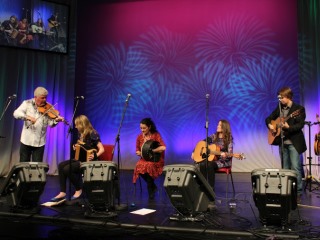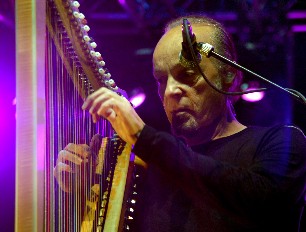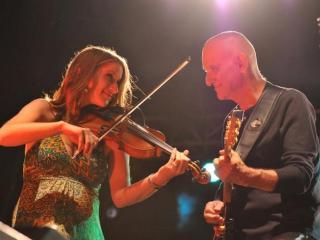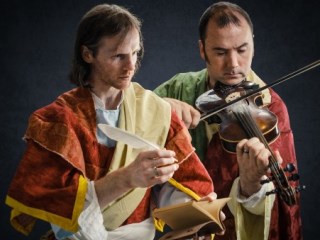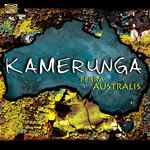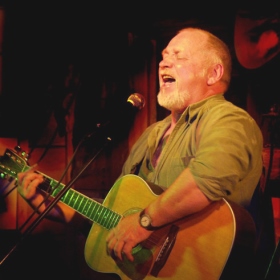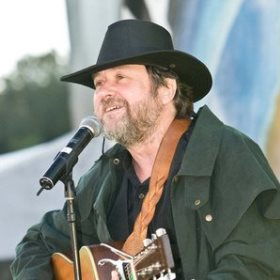FolkWorld #60 07/2016
 Lorient Interceltic Festival
Lorient Interceltic Festival
»The Year of Australia«
5 - 14 August 2016
- 6th August Australia Inauguration Evening
- 8th August Grande Nuit - Australia’s Big Night
- 12th August “Two Stars of the Southern Cross”
with Archie Roach and Tommy Emmanuel
- and many other concerts with:
Christopher McLeish
Claymore
Eric Bogle
Graham Dodsworth
Jane Rutter
Queensland Irish Pipe Band
Saoirse
SÁSTA
Siobhan Owen
Sylvestre Soleil
The City of Auckland Pipe Band
The Highland Dance Company
- 7th/9th/10th and 11th August 2016
Interceltic Nights
350 years of the city of Lorient
- 7th August 2016 The Grand Parade of the Celtic Nations
- 7th August 2016 Alan Stivell 50 Years on Stage
- 11th August Dan Ar Braz and the Brittany Symphonic Orchestra
- 11
1916 - Visionaries and their Words
100 years of the Irish Rebellion
Music of Australia
Situated over 15,000 km from the shores of Brittany, Australia is a diverse, cosmopolitan and multicultural country,
forged by the Celtic population and culture. It is estimated that approximately half of its current 23 million inhabitants
are of Celtic origin, particularly Irish and Scottish.
The festival-goers of the 46th Lorient Interceltic Festival will (re)discover and enjoy
the music and creativity of those «Celts under the Southern Cross».
The music of Australia has an extensive history made of music societies. Indigenous Australian music is a part of the unique heritage of a 40,000–60,000 year history which produced the iconic didgeridoo. Contemporary fusions of Indigenous and Western styles (exemplified in the works of No Fixed Address, Yothu Yindi, Christine Anu and Geoffrey Gurrumul Yunupingu) mark distinctly Australian contributions to world music. During its early western history, Australia was a collection of British colonies, and Australian folk music and bush ballads such as Waltzing Matilda were heavily influenced by Anglo-Celtic traditions, while classical forms were derived from those of Europe. Contemporary Australian music ranges across a broad spectrum with trends often concurrent with those of the US, the UK, and similar nations – notably in the Australian rock and Australian country music genres. Tastes have diversified along with post-World War II multicultural immigration to Australia.
Indigenous music
Indigenous Australian music refers to the music of Aborigines and Torres Strait Islanders. Music forms an integral part of the social, cultural and ceremonial observances of these peoples, and has been so for over 60,000 years. Traditional Indigenous music is best characterised by the didgeridoo, the best-known instrument, which is considered by some to be the world's oldest. Archaeological studies of rock art in the Northern Territory suggest people of the Kakadu region were playing the instrument 15,000 years ago.
Contemporary Indigenous Australian music has covered numerous styles, including rock and roll, country, hip hop, and reggae. Jimmy Little is regarded as the first Aboriginal performer to achieve mainstream success, with his debut 1964 song "The Royal Telephone" highly popular and successful. In 2005, Little was presented with an honorary doctorate in music by the University of Sydney. Despite the popularity of some of his work, Little failed to launch Indigenous music in the country—from the 1970s onwards, groups such as Coloured Stone, Warumpi Band, and No Fixed Address would help improve the image of the genre. It would be Yothu Yindi that would bring Indigenous music to the mainstream, with their 1991 song "Treaty", from the album Tribal Voice, becoming a hit. would go on to reach No. 11 on the ARIA Singles Chart. The band's performances were based on the traditional Yolngu dance, and embodied a sharing of culture. The success of Yothu Yindi—winners of eight ARIA Awards—was followed in by Kev Carmody, Tiddas, Christine Anu, and numerous other Indigenous Australian musicians.
Indigenous Australian music is unique, as it dates back more than 60,000 years to the prehistory of Australia and continues the ancient songlines through contemporary artists as diverse as: David Dahwurr Hudson, Jimmy Little, Warumpi Band, Yothu Yindi, Tiddas, Wild Water, Christine Anu, Geoffrey Gurrumul Yunupingu, Saltwater Band, Nabarlek, Nokturnl, the Pigram Brothers, Coloured Stone, Blekbala Mujik, Kev Carmody, Archie Roach and Ruby Hunter.
Folk music
For much of its history, Australia's bush music belonged to an oral and folkloric tradition, and was only later published in print in volumes such as Banjo Paterson's Old Bush Songs, in the 1890s. The distinctive themes and origins of Australia's "bush music" or "bush band music" can be traced to the songs sung by the convicts who were sent to Australia during the early period of the British colonisation, beginning in 1788. Early Australian ballads sing of the harsh ways of life of the epoch and of such people and events as bushrangers, swagmen, drovers, stockmen and shearers. Convict and bushranger verses often railed against government tyranny. Classic bush songs on such themes include: The Wild Colonial Boy, Click Go The Shears, The Eumeralla Shore, The Drover's Dream, The Queensland Drover, The Dying Stockman and Moreton Bay.
Later themes which endure to the present include the experiences of war, of droughts and flooding rains, of Aboriginality and of the railways and trucking routes which link Australia's vast distances. Isolation and loneliness of life in the Australian bush has been another theme.
Waltzing Matilda, often regarded as Australia's unofficial National anthem, is a quintessential Australian folk song, influenced by Celtic folk ballads. Country and folk artists such as Tex Morton, Slim Dusty, Rolf Harris, The Bushwackers, John Williamson, and John Schumann of the band Redgum have continued to record and popularise the old bush ballads of Australia through the 20th and into the 21st century – and contemporary artists including Sara Storer and Lee Kernaghan draw heavily on this heritage.
Australia has a unique tradition of folk music, with origins in both the indigenous music traditions of the original Australian inhabitants, as well as the introduced folk music (including sea shanties) of 18th and 19th century Europe. Celtic, English, German and Scandinavian folk traditions predominated in this first wave of European immigrant music. The Australian tradition is, in this sense, related to the traditions of other countries with similar ethnic, historical and political origins, such as New Zealand, Canada, and the United States. The Australian indigenous tradition brought to this mix novel elements, including new instruments, some of which are now internationally familiar, such as the didgeridoo of Northern Australia.
A number of British singers have spent periods in Australia and have included Australian material in their repertoires, e.g. A. L. Lloyd, Martin Wyndham-Read and Eric Bogle.
Folk revival
Notable Australian exponents of the folk revival movement included both European immigrants such as Eric Bogle, noted for his sad lament to the battle of Gallipoli "And the Band Played Waltzing Matilda", and indigenous Australians like Archie Roach and Paul Kelly. Kelly's lyrics capture the vastness of the culture and landscape of Australia by chronicling life about him for over 30 years. David Fricke from Rolling Stone calls Kelly "one of the finest songwriters I have ever heard, Australian or otherwise.". In the 1970s, Australian Folk Rock brought both familiar and less familiar traditional songs, as well as new compositions, to live venues and the airwaves. Notable artists include The Bushwacker Band and Redgum. Redgum are known for their 1983 anti-war protest song "I Was Only Nineteen", which peaked at No. 1 on the National singles charts. The 1990s brought Australian Indigenous Folk Rock to the world, led by bands including Yothu Yindi. Australia's long and continuous folk tradition continues strongly to this day, with elements of folk music still present in many contemporary artists including those generally thought of as Rock, Heavy Metal and Alternative Music. Gold coast musician Mark Boulle is pioneering the way with his original Indie Folk music. This truly Australian sound continues to add to the strong tradition of folk based music coming out from down under.
Popular music
Country music
Australia has a long tradition of country music, which has developed a style quite distinct from its US counterpart. The early roots of Australian country are related to folk traditions of Ireland, England, Scotland and many diverse nations. "Botany Bay" from the late 19th century is one example. Waltzing Matilda, often regarded by foreigners as Australia's unofficial national anthem, is a quintessential Australian country song, influenced more by Celtic folk ballads than by American Country and Western music. This strain of Australian country music, with lyrics focusing on strictly Australian subjects, is generally known as "bush music" or "bush band music." The most successful Australian bush band is Melbourne's The Bushwackers, active since the early 1970s.
Another, more Americanized form of Australian country music was pioneered in the 1930s by such recording artists as Tex Morton, and later popularized by Slim Dusty, best remembered for his 1957 song "A Pub With No Beer". Dusty married singer-songwriter Joy McKean in 1951 and went on to become Australia's biggest selling domestic music artist with more than 7 million record sales. British-born country singer and yodeller, Frank Ifield, was one of the first Australian post-war performers to gain widespread international recognition. After returning to the UK in 1959 Ifield was successful in the early 1960s, becoming the first performer to have three consecutive number-one hits on the UK charts: "I Remember You", "Lovesick Blues" (both 1962) and "The Wayward Wind" (1963). "I Remember You" was also a Top 5 hit in the US. Australian country artists including Olivia Newton-John, Sherrie Austin, and Keith Urban have achieved considerable success in the USA. In recent years local contemporary country music, featuring much crossover with popular music, had enjoyed considerable popularity in Australia; notable musicians of this genre include David Hudson, John Williamson, Gina Jeffreys, Lee Kernaghan, Troy Cassar-Daley, Sara Storer, Felicity Urquhart and Kasey Chambers. Others influenced by the genre include Nick Cave, Paul Kelly, The John Butler Trio, Jagged Stone and The Waifs.
Popular Australian country songs include Click Go the Shears (Traditional), Lights on the Hill (1973), I Honestly Love You (1974), True Blue (1981), and Not Pretty Enough (2002).
Australian Folk Music
Australian folk music is a term which may be applied to traditional music from the large variety of immigrant cultures and those of the original Australian inhabitants.
Celtic, English, German and Scandinavian folk traditions predominated in the first wave of European immigrant music. The Australian tradition is, in this sense, related to the traditions of other countries with similar ethnic, historical and political origins, such as New Zealand, Canada and the United States.
Bush music
For much of its history, Australia's bush music belonged to an oral and folkloric tradition, and was only later published in print in volumes such as Banjo Paterson's Old Bush Songs, in the 1890s. More than 70 of Banjo Paterson's poems have been set to music by Wallis & Matilda since 1980. The distinctive themes and origins of Australia's "bush music" or "bush band music" can be traced to the sea shanties of 18th and 19th century Europe and other songs sung by the convicts who were sent to Australia during the early period of the British colonisation, beginning in 1788. Early Australian ballads sing of the harsh ways of life of the epoch and of such people and events as bushrangers, swagmen, drovers, stockmen and shearers. Convict and bushranger verses often railed against government tyranny. Classic bush songs on such themes include: The Wild Colonial Boy, Click Go The Shears, The Eumeralla Shore, The Drover's Dream, The Queensland Drover, The Dying Stockman and Moreton Bay.
Later themes which endure to the present include the experiences of war, of droughts and flooding rains, of Aboriginality and of the railways and trucking routes which link Australia's vast distances. Isolation and loneliness of life in the Australian bush has been another theme.
Waltzing Matilda, often regarded as Australia's unofficial national anthem, is a quintessential Australian folk song, influenced by Celtic folk ballads.
Country and folk artists such as Tex Morton, Slim Dusty, Rolf Harris, The Bushwackers, John Williamson, and John Schumann of the band Redgum have continued to record and popularise the old bush ballads of Australia through the 20th and into the 21st century – and contemporary artists including Sara Storer and Lee Kernaghan draw heavily on this heritage.
A number of British singers have spent periods in Australia and have included Australian material in their repertoires, e.g. A. L. Lloyd, Martin Wyndham-Read, Eric Bogle.
In adapted forms Indigenous Australian music influenced the development of Australian country music and particularly after the folk revival, Australian folk music.
A similar bush band tradition is also found in New Zealand. :)
Folk rock
The Australian indigenous tradition brought to this mix novel elements, including new instruments, some of which are now internationally familiar, such as the didgeridoo of Northern Australia.
Notable Australian exponents of the folk revival movement included both European immigrants such as Eric Bogle, noted for his sad lament to the battle of Gallipoli "And the Band Played Waltzing Matilda", and indigenous Australians like Archie Roach and many others. In the 1970s, Australian Folk Rock brought both familiar and less familiar traditional songs, as well as new compositions, to live venues and the airwaves. Notable artists include The Bushwacker Band and Redgum. Redgum are known for their 1983 anti-war protest song "I Was Only Nineteen", which peaked at #1 on the National singles charts. The 1990s brought Australian Indigenous Folk Rock to the world, led by bands including Yothu Yindi. Australia's long and continuous folk tradition continues strongly to this day, with elements of folk music still present in many contemporary artists including those generally thought of as Rock, Heavy Metal and Alternative Music.
History
Music of the convict era
European settlement of Australia began with the transportation of convicts from Great Britain. These convicts brought songs with them which were rapidly adapted to Australian conditions. Songs such as Moreton Bay based on the Irish song Boolavogue described the sufferings of the convicts.
The most notable songwriter of this era was Frank Macnamara, better known as Frank the Poet, author of such well known songs as Bold Jack Donahue, which developed into The Wild Colonial Boy.
The convict tradition also came to include songs popular in the English music halls, such as Botany Bay, and broadsheet ballads such as The Black Velvet Band.
19th century
In the century following European settlement of Australia, a musical tradition developed in the bush, particularly among itinerant workers such as shearers. As in the convict era, most bush music was made by setting new words to well-known traditional or popular songs. The Bulletin, known as the 'Bushman's bible' played a prominent role in publishing and popularising new songs.
1900-1950
As in other countries, the spread of recorded music and the arrival of radio spelt the end of Australian bush music in its traditional form. American country music largely displaced traditional Australian music in the bush. However, traditional dance music proved more durable in this period.
1951–2000
Folk music in the 1950s onwards lost popularity in mainstream culture with the creation of rock music and its popularity among the younger generations of the time. However, bush bands, as currently formulated, experienced a revival in 1953 with the musical play Reedy River, which was first produced and published by the New Theatre (Sydney) and most recently produced in 2002. Written by Dick Diamond, the musical featured twelve or so Australian songs, which included Doreen Jacobs' setting of Helen Palmer's "Ballad of 1891", as well as the title song, Chris Kempster's setting of Lawson's "Reedy River". The backing band for this popular stage production was "The Bushwhackers", who had formed a year earlier in 1952. As the musical was performed in Brisbane and other Australian cities, local "bush bands" modeled on the Sydney group, such as Brisbane's "The Moreton Bay Bushwhackers" featuring Stan Arthur and Bill Scott {author}, sprang up in each place; many of these remained together following the closing of the musical, and spawned other, similar groups.
This traditional period was superseded by a revival of folk music that featured more contemporary forms. The Australian band The Seekers emerged in 1963 and blended traditional music, contemporary folk music and pop, an illustration of the rapid evolution and diversification of folk music that took place in the mid-1960s. In Brisbane, from 1962 until it closed in 1977, the Folk Centre (renting facilities on Ann Street, adjacent to the People's Palace hotel) served as a crucible for both established and emerging artists. Stan and Kathy Arthur ran it, and the Wayfarers (Stan Arthur, Garry Tooth, Bob Stewart & Alistair Frazer) were the mainstay of the venue; while emerging local groups included the Wildwood Trio and the Babayaga Trio. In Perth, W.A. in the early 70's, Stan Hastings ran a popular folk club called The Stables (a music venue in the Governor Broome Hotel) where Stan and his son Greg were instrumental in starting a Bush Band - Mucky Duck Bush Band. The 'Duck' turned professional in 1974, taking Australian bush music to many regional areas of W.A. Greg Hastings left the band in '79 to go solo and the band has kept going, with numerous different members throughout the years.
2001-Present
There has been somewhat of a revival of Australian folk music in recent years with many folk bands and musicians becoming quite successful. For example, Geoffrey Gurrumul Yunupingu whose debut album Gurrumul was nominated for four ARIA awards and reached 2x Platinum. Other Bands such as Angus & Julia Stone or Boy & Bear have also heavily drawn on folk influences.
Known internationally, were the Bushwackers (spelt without the "h" as in the earlier Bushwhackers Band of the 1950s), who formed in Melbourne and were active from the early 1970s to 1984. Their style was infused with Celtic music (i.e. reels and jigs) to a greater extent than previous bush bands, and they used an electric bass guitar in place of the more traditional bush bass. The period leading up to and following Australia's Bicentenary, 1988, saw a marked resurgence in bush music and bush dances that lasted for many years.
Many bands also bearing the rock influence and adding original music rode this Australiana wave. Examples are the Ants Bush Band, Eureka!, Rantan Bush Band and Bullamakanka. Few bands formed in the 1980s survive to this day. One exception, while seeing many player changes over the years, is Currency Lads (Sydney), which still performs regularly (2009). Brisbane's Rantan Bush Band, formed in 1977, continues to perform commercially on at least a weekly basis (2010) and still has three of its original line up.
In recent years the emergence of bands such as The Currency (Melbourne), The Handsome Young Strangers (Sydney) and Sydney City Trash (Sydney) has moved bush music into rock and roll venues and major festival stages, with a blended style that includes rock drums and guitars whilst combining with Celtic influences. The Handsome Young Strangers lean more towards the traditional style of bands such as The Bushwackers, whilst The Currency and Sydney City Trash incorporate both punk and Celtic styles. Rantan Bush Band has maintained a folk/country blend as its trademark and performs both traditional Australian songs as well as Australian country music and a supporting repertoire of regular pop and rock music for dancing.
Bush bands play music for bush dances, in which the dance program is usually based on dances known to have been danced in Australia from colonial times to the folk revival in the 1950s. Contemporary dances, composed in the traditional style, are also featured at bush dances.
From Wikipedia, the free encyclopedia
[en.wikipedia.org/wiki/Music_of_Australia,
en.wikipedia.org/wiki/Australian_folk_music,
en.wikipedia.org/wiki/Indigenous_Australian_music].
Wikipedia® is a registered trademark of the Wikimedia Foundation, Inc., a non-profit organization.
Text is available under the Creative Commons Attribution-ShareAlike License.
Date: June 2016.
Photo Credits:
(1), (4)-(5) Festival Interceltique Lorient,
(2) Saoirse,
(3) Archie Roach,
(6) Eric Bogle,
(7) Alan Stivell,
(8) Dan Ar Braz,
(9) Lorcán Mac Mathúna,
(10) Graham Dodsworth,
(11) Banjo Paterson,
(12) Kamerunga,
(13) Siobhan Owen,
(14) Tommy Emmanuel
(unknown/website).
FolkWorld - Home of European Music
 Layout & Idea of FolkWorld © The Mollis - Editors of FolkWorld
Layout & Idea of FolkWorld © The Mollis - Editors of FolkWorld
